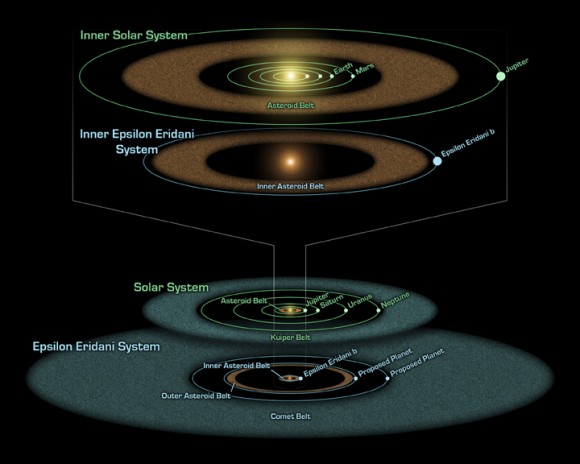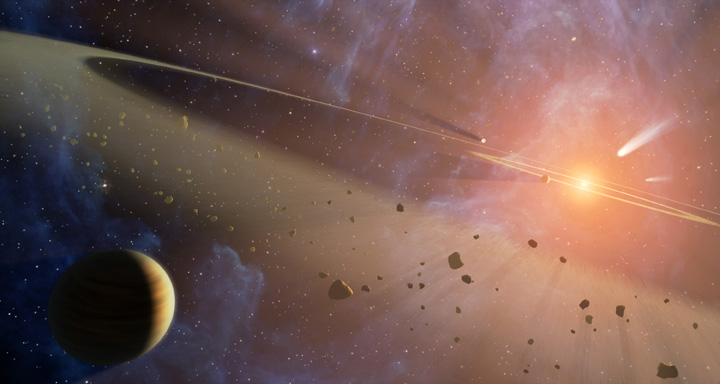[/caption]
Back in 2000, astronomers discovered a Jupiter-sized planet orbiting the nearby star Epsilon Eridani. Since that star system is listed in some Star Trek lore as the location of the fabled planet Vulcan, astronomers joked they had found Spock’s homeworld. But enticing new discoveries of the Epsilon Eridani system implies it could be a younger twin to our own solar system. It has two rocky asteroid belts and an outer icy ring, making it a triple-ring system. The inner asteroid belt looks strikingly similar to the one in our solar system, while the outer asteroid belt holds 20 times more material. All of this material implies that unseen planets lie hidden, shaping the rings. But if another civilization possibly could have developed in this region, let’s hope they are more like Spock than Kirk’s evil twin….

Epsilon Eridani is the ninth closest star to the Sun. It is slightly smaller and cooler than our own Sun, and is located about 10.5 light-years from Earth in the constellation Eridanus. Epsilon Eridani is visible to the unaided eye, and is younger than the Sun, with an approximate age of 850 million years.
Astronomers say Epsilon Eridani and its planetary system show remarkable similarities to our solar system at a comparable age.
“Studying Epsilon Eridani is like having a time machine to look at our solar system when it was young,” said Smithsonian astronomer Massimo Marengo. Dana Backman from the SETI Institute agreed, saying, “This system probably looks a lot like ours did when life first took root on Earth.” The two astronomers’ paper will appear in the Jan. 10 issue of The Astrophysical Journal.

As the above image shows, the two systems are structured similarly, and both host asteroids (brown), comets (blue) and planets (white dots). Epsilon Eridani’s inner asteroid belt is located at about the same position as ours, approximately three astronomical units from its star (an astronomical unit is the distance between Earth and the sun.). The system’s second, denser belt lies at about the same place where Uranus orbits in our solar system, or 20 astronomical units from the star. Epsilon Eridani is thought to have planets orbiting near the rims of its two belts. The “Vulcan” –like home world was identified in 2000 via the radial velocity technique. The second planet orbiting near the rim of the outer asteroid belt at 20 astronomical units was inferred when Spitzer discovered the belt. A third planet might orbit in Epsilon Eridani at the inner edge of its outermost comet ring, which lies between 35 and 90 astronomical units. This planet was first hinted at in 1998 due to observed lumpiness in the comet ring.
When the Sun was 850 million years old, theorists calculate that our Kuiper Belt looked about the same as that of Epsilon Eridani. Since then, much of the Kuiper Belt material was swept away, some hurled out of the solar system and some sent plunging into the inner planets in an event called the Late Heavy Bombardment. (The Moon shows evidence of the Late Heavy Bombardment—giant craters that formed the lunar seas of lava called mare.) It is possible that Epsilon Eridani will undergo a similar dramatic clearing in the future.
“Epsilon Eridani looks a lot like the young solar system, so it’s conceivable that it will evolve similarly,” said Marengo.
The Spitzer data show gaps between each of the three rings surrounding Epsilon Eridani. Such gaps are best explained by the presence of planets that gravitationally mold the rings, just as the moons of Saturn constrain its rings.
“Planets are the easiest way to explain what we’re seeing,” stated Marengo.
Future studies may detect these currently unseen worlds, as well as any terrestrial planets that may orbit inside the innermost asteroid belt.
Source: Harvard Smithsonia CfA


Epsilon Eridani’s young stellar age is also accompanied by a faster rotation, more of a variable flare and magnetospheric activity and a mass loss 30-fold our own Sol, resulting in an astrosphere extending 8000 AU from the star and a bow shock extending 1800 AU from the primary resulting in an apparent size of 42 arcminutes from a planet orbiting at Earths’ distance from our sun (1 AU ). Wikipedia has a thorough and extensive listing of the Epsilon Eridani system at http://en.wikipedia.org/wiki/Epsilon_Eridani. Clearly many similarities exist between our solar system & Epsilon Eri, although many differences also exist between the two stellar systems. Great shot of evil Kirk, Nancy 🙂
Actually Vulcan’s home system is 40 Eridani, not Epsilon Eridani.
KHAAAAAAAAAAAAAAAAAAAAAAN!
I think this seach for Vulcan will end in utter disappointment or in the confirmation of a theory in physics, just as the last one.
If Vulcan is there should Andoria be near also?
Yeah, as has been pointed out already, 40 Eri is the solar system that Vulcan is in.
@ Jim. Andoria orbits Eps Indi.
Hmm… a young solar system. Consider this. In a “few” billion years our own Sun will be giving us a hard time but by then with any luck Epsilon Eri’s “heavy bombardment” could be over AND we as a civilization could possess the technology to make an interstellar hop of mere 10.5 ly. So there is hope for us yet. Of course, this assumes there is a planet suitable for humans (and perhaps some animals and plants from Earth) to live on. Hmm… Let’s do some research into space travel! And of course let’s get more civilized – no need to spread bad habits around the galaxy.
Regards,
/Adam
The full paper by D. Bachman et can be found posted at the arXiv.org site for Oct. 28, 2008 @ http://arxiv.org/PS_cache/arxiv/pdf/0810/0810.4564v1.pdf. Detailed info gleaned by Spitzer and the California Submillimeter Observatory (CSO)on the Epsilon Eridani system can be found here.
Studying the finer details of such systems similar to our own (both in “younger” and “older” stages) could perhaps tell us something about the past, present and even future of our own part of the universe. Perhaps even of possible types of cosmic events we have little idea of at the moment (possibility of “unknown” disasters and opportunities).
I think we should declare war, just in case.
Tell Bush the system is full of oil. We’ll have our first interstellar mission in no time.
Funded by Halliburton, of course.